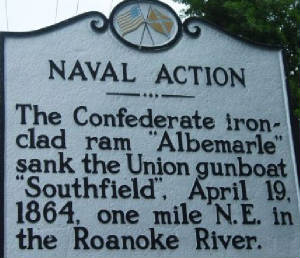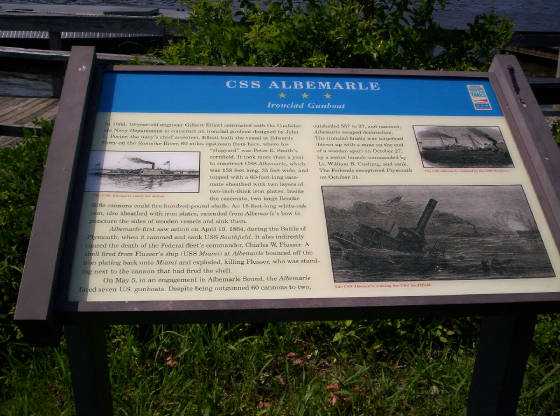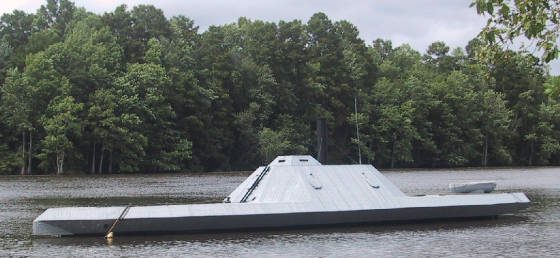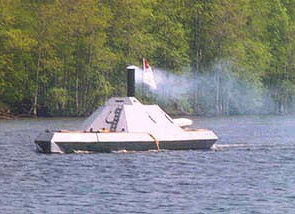|
THE IRONCLAD RAM ALBEMARLE
CSS IRONCLAD RAM ALBEMARLE
The formidable Confederate ironclad CSS Albemarle was instrumental
in the recapture of Plymouth, North Carolina, in April 1864, and she was also responsible for the destruction of 29 Union
ships.
| CSS Albemarle |

|
| CSS Albemarle |
The 1863 Confederate contract
to build an ironclad ram was granted to a nineteen year old North Carolina soldier named Gilbert Elliott who would oversee
the bulk of its construction in a cornfield in Halifax County. The ship, later named the Albemarle, was intended, if
ever completed, to operate on the waters of Albemarle and Pamlico Sounds. Elliott began building the Albemarle at Tillery’s
Farm, seven miles below Halifax on the Roanoke River.
Interesting Fact: Practically every Civil War ship was constructed in the traditional shipyard, however, the CSS
Albemarle was built in a southern cornfield.
He moved the operation downstream to Edwards Ferry in March 1863. There, on the property of Peter E. Smith, a shipyard
was built in a cornfield by the river. While Smith brought in or built the equipment needed, Elliot combed the state for iron,
collecting old railroad iron, broken boilers, and even buckets of bolts. Regarding the difficulties in completing the ship,
Elliott wrote “No vessel was ever constructed under more adverse circumstances.”
| CSS Albemarle Ironclad Ram |

|
| CSS Albemarle Ironclad Ram |
In March 1864, after about a year
at what became known as the Edwards Ferry Shipyard, the Albemarle was launched about two miles downriver to Hamiliton, where the two layers of iron plating were applied. Completed, the ship was 152 feet
long, 45 feet wide, with a draft of eight feet. Although the eighteen-foot ram was the Albemarle’s primary weapon,
the vessel was also outfitted with six gunports and two rotating eight-inch Brooke rifled guns. The two engines, built by
Elliot out of an assortment of odds and ends, were 200 horsepower each.
| CSS Albemarle (Replica) |

|
| (Photographed in 2003) |
Genera Robert F. Hoke convinced Commander James W. Cooke to have the
Albemarle ready in time to aid in his planned attack on the Union occupying forces at Plymouth.
On April 17, 1864, the Albemarle was commissioned and launched, departing directly for Plymouth. Since the iron plating
was not yet complete, forges were installed on the deck and mechanics, carpenters and blacksmiths boarded to work on the ship
as it floated down the Roanoke River. As work was completed, Cooke
made brief stops to drop off surplus men, materials, and equipment. Elliott volunteered to join the crew as Cooke’s
aide and, on the night of April 17, completed a reconnaissance mission that made it possible for a furtive early morning journey
through enemy obstacles in river.
| CSS Albemarle (Replica) |

|
| CSS Albemarle reproduction |
The Albemarle easily bypassed Fort Gray, slipping farther downstream toward Plymouth. Two Union steamers,
Miami and Southfield, were targets of the next naval action.
The Albemarle rammed the Southfield, which sank, and Cooke turned his attention to the Miami. The Miami’s
commander, Charles W. Flusser, was killed when a shell that he fired at the Albemarle ricocheted back to the Miami,
so close were the two vessels. Having already taken punishing shellfire, the Miami then fled downstream. The Albemarle
was liberated to steam to Plymouth and pound the city’s Union defenses, providing significant support to Hoke’s
troops who recaptured Plymouth on April 20.
Though the Albemarle fought successfully in only one other engagement,
the ram, moored at Plymouth, remained a threat to Union forces in eastern North Carolina. Lieutenant William B. Cushing was
dispatched to North Carolina with orders to destroy the Albemarle. On October 27, 1864, Cushing torpedoed the ram from a small launch in the river, clearing the way for Union forces to recapture Plymouth
and subsequently the entire sound region. Near the end of the war the Albemarle was raised, towed to Norfolk, and sold
at public auction.
References: John G. Barrett, The Civil War in North Carolina (1963); William B. Trotter, Ironclads
and Columbiads: The Civil War in North Carolina, The Coast (1989); Robert G. Elliott, Ironclad of the Roanoke (1994);
Gilbert Elliott, “The Ram ‘Albemarle,’” in Walter Clark (ed.), Histories of the Several Regiments
and Battalions from North Carolina in the Great War (1901), V, 314-323.
Recommended Reading: The Hunt for the Albemarle:
Anatomy of a Gunboat War (Hardcover). Description:
On a muddy waterway, once called the River of Death, James Cooke and Charles Flusser met again after parting
when the Civil War started. Once both navy lieutenants, they now were the opponents in naval warfare. Confederate Navy Lieutenant
James Cooke had as many years of active naval service as Charles Flusser had years of living. Cooke was a devoted family man
while Flusser was a bachelor with a mind for young Southern women, whiskey, cigars, fast horses, and early promotion. Continued
below...
The Confederate
ironclad Albemarle was the key to the river wars in North Carolina. Flusser's
search for this ship would determine the success or failure of the Union navy in securing the North Carolina coast and
rivers. James Cooke and the Confederates knew their only chance to break the blockade was with the new ironclad. The Hunt
for the Albemarle
is the dramatic story of these two men and their destiny. Both of these men shared one common characteristic. Each was willing
to die for the cause he believed was right.
Advance to:
Recommended
Reading: A History of Ironclads: The Power of Iron over Wood. Description: This
landmark book documents the dramatic history of Civil War ironclads and reveals how ironclad warships revolutionized naval
warfare. Author John V. Quarstein explores in depth the impact of ironclads during the Civil War and their colossal effect
on naval history. The Battle of Hampton Roads was one of history's greatest naval engagements. Over the course of two days
in March 1862, this Civil War conflict decided the fate of all the world's navies. It was the first battle between ironclad
warships, and the 25,000 sailors, soldiers and civilians who witnessed the battle vividly understood what history would soon
confirm: wars waged on the seas would never be the same. Continued below…
About the Author: John V. Quarstein is an award-winning author and historian. He is director
of the Virginia
War Museum in Newport News and chief historical advisor for The Mariners' Museum's new USS Monitor Center
(opened March 2007). Quarstein has authored eleven books and dozens of articles on American, military and Civil War history,
and has appeared in documentaries for PBS, BBC, The History Channel and Discovery Channel.
Recommended
Reading: Iron Afloat:
The Story of the Confederate Armorclads.
Description: William N. Still's book is rightfully referred to as the standard of Confederate Naval history. Accurate and
objective accounts of the major and even minor engagements with Union forces are combined with extensive background information.
This edition has an enlarged section of historical drawings and sketches. Mr. Still explains the political background that
gave rise to the Confederate Ironclad program and his research is impeccable. An exhaustive literature listing rounds out
this excellent book. While strictly scientific, the inclusion of historical eyewitness accounts and the always fluent style
make this book a joy to read. This book is a great starting point.
Recommended
Reading: Civil War Ironclads: The U.S. Navy and Industrial Mobilization (Johns Hopkins
Studies in the History of Technology). Description: "In this impressively researched and broadly conceived study, William
Roberts offers the first comprehensive study of one of the most ambitious programs in the history of naval shipbuilding, the
Union's ironclad program during the Civil War. Perhaps more importantly, Roberts also provides
an invaluable framework for understanding and analyzing military-industrial relations, an insightful commentary on the military
acquisition process, and a cautionary tale on the perils of the pursuit of perfection and personal recognition." - Robert
Angevine, Journal of Military History "Roberts's study, illuminating on many fronts, is a welcome addition to our understanding
of the Union's industrial mobilization during the Civil War and its inadvertent effects on the postwar U.S. Navy." - William
M. McBride, Technology and Culture"
Recommended
Reading: A History of the Confederate Navy
(Hardcover). From Publishers Weekly: One of the most prominent European scholars of the Civil War weighs in with a provocative
revisionist study of the Confederacy's naval policies. For 27 years, University of Genoa history professor Luraghi (The Rise
and Fall of the Plantation South) explored archival and monographic sources on both sides of the Atlantic to develop a convincing
argument that the deadliest maritime threat to the South was not, as commonly thought, the Union's blockade but the North's
amphibious and river operations. Confederate Navy Secretary Stephen Mallory, the author shows, thus focused on protecting
the Confederacy's inland waterways and controlling the harbors vital for military imports. Continued below…
As a result,
from Vicksburg
to Savannah to Richmond, major
Confederate ports ultimately were captured from the land and not from the sea, despite the North's overwhelming naval strength.
Luraghi highlights the South's ingenuity in inventing and employing new technologies: the ironclad, the submarine, the torpedo.
He establishes, however, that these innovations were the brainchildren of only a few men, whose work, although brilliant,
couldn't match the resources and might of a major industrial power like the Union. Nor did
the Confederate Navy, weakened through Mallory's administrative inefficiency, compensate with an effective command system.
Enhanced by a translation that retains the verve of the original, Luraghi's study is a notable addition to Civil War maritime
history. Includes numerous photos.
Recommended
Reading: Naval Campaigns
of the Civil War. Description: This analysis
of naval engagements during the War Between the States presents the action from the efforts at Fort Sumter during the secession
of South Carolina in 1860, through the battles in the Gulf of Mexico, on the Mississippi River, and along the eastern seaboard,
to the final attack at Fort Fisher on the coast of North Carolina in January 1865. This work provides an understanding of
the maritime problems facing both sides at the beginning of the war, their efforts to overcome these problems, and their attempts,
both triumphant and tragic, to control the waterways of the South. The Union blockade, Confederate privateers and commerce
raiders are discussed, as is the famous battle between the Monitor and the Merrimack.
Continued below…
An overview
of the events in the early months preceding the outbreak of the war is presented. The chronological arrangement of the campaigns
allows for ready reference regarding a single event or an entire series of campaigns. Maps and an index are also included.
About the Author: Paul Calore, a graduate of Johnson and Wales University,
was the Operations Branch Chief with the Defense Logistics Agency of the Department of Defense before retiring. He is a supporting
member of the U.S. Civil War Center and the Civil War Preservation Trust and has also written Land Campaigns of the Civil
War (2000). He lives in Seekonk, Massachusetts.
Recommended Reading:
The Confederate Navy in Europe.
Description: The Confederate Navy in Europe is an account of the Confederate officers and officials who went on missions to
Britain and France
to buy ships for the CS Navy, and to support CSN operations on the high seas, such as commerce raiding. Spencer tells the
story of how some officers rose to the occasion (some did not) and did a lot with limited resources. The majority of the ships
ordered never reached America. Shipbuilding
takes time, and as the war dragged on the European powers were persuaded by Confederate battlefield misfortunes and US diplomatic pressure that it was most expedient to deny
the sales of such innovative designs as ocean-going ironclads. Like other out-manned and out-gunned powers, the CSA did have
to resort to ingenuity and innovation.
|

